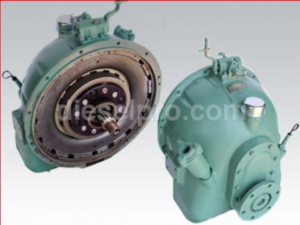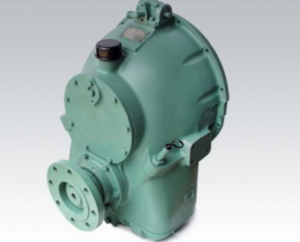Introduction

This comprehensive FAQ guide addresses the most common questions related to Allison M and MH Series marine transmissions. These units are widely used in commercial and recreational marine applications for their durability, straightforward design, and hydraulic operation. Whether you’re a boat owner, operator, or marine technician, this section is designed to support your understanding and maintenance efforts. For detailed service instructions, tolerances, or overhaul specifications, refer to the OEM service manual.
General Operation FAQs For Allison M & MH Marine Transmissions

1. What do the designations “M” and “MH” mean?
The “M” indicates a marine transmission, and “MH” refers to the heavy-duty marine transmission series. The MH models are typically rated for higher torque and continuous-duty operations.
2. What types of gear reductions are available?
Gear reductions include ratios such as 1.0:1, 1.1:1, 1.5:1, 1.7:1, 2.0:1, 2.5:1, 3.0:1, 3.7:1, and 4.5:1. The model number corresponds to the gear ratio (e.g., MH30 = 3.0:1 ratio).
3. Can these transmissions accommodate both left-hand and right-hand engine rotation?
Yes. The transmissions are available in configurations for both clockwise and counterclockwise engine rotation, as indicated by the model suffix (e.g., R for right-hand, L for left-hand).
4. Are these transmissions suitable for both pleasure and commercial vessels?
Yes. M Series are often used in pleasure applications, while MH Series are designed for commercial, continuous-duty operations.
5. What kind of clutches are used?
Allison M & MH marine transmissions use single-plate, hydraulically actuated, spring-released, oil-cooled clutches. They are self-adjusting and do not require manual adjustment during service.
Installation and Setup FAQs For Allison M & MH Marine Transmissions

6. How is the transmission mounted?
The transmission is typically bolted directly to the engine flywheel housing and is cradle-mounted with side pads that support the rear housing.
7. Does the transmission use the same oil as the engine?
Yes. The oil used should be the same type and viscosity as used in the engine, typically SAE 30, SAE 40, or SAE 15W-40 depending on the ambient temperature.
8. What is the oil capacity?
-
M Series and shallow-profile MH models: Approximately 6 quarts (5.5 liters)
-
Deep-profile MH models: Approximately 6.5 quarts (6 liters)
9. Where is the oil dipstick located?
On most models, the oil dipstick (gauge rod) is located either on the rear of the flywheel housing or on the side of the reduction gear housing.
10. What type of oil filter is used?
A full-flow, replaceable element is used for filtering. It should be changed at regular service intervals or whenever the oil is changed.
Operation and Usage FAQs For Allison M & MH Marine Transmissions

11. Can you shift from forward to reverse at any speed?
Shifting through neutral can technically be done at any engine speed, but for longest clutch life, it’s advised to idle the engine momentarily between shifts.
12. What happens if I try to tow the boat with the engine off?
Since the oil pump is engine-driven, no lubrication or clutch pressure will be present. You must disconnect the driveline or prevent the propeller shaft from rotating if towing for more than half a mile.
13. Is full torque shifting recommended?
No. Full torque shifting should be avoided except in emergencies.
14. What does the selector valve do?
The selector valve controls the flow of hydraulic oil to the forward or reverse clutch. It determines whether the transmission is in forward, reverse, or neutral.
15. How is the selector valve actuated?
It is manually actuated through a lever that moves the control valve lever mechanically, causing oil to shift between forward and reverse circuits.
Maintenance FAQs For Allison M & MH Marine Transmissions
16. How often should the oil be changed?
Every 500 hours or once per year, whichever comes first. Always change the filter during an oil change.
17. What is the correct oil level check procedure?
Check the oil while the engine is running and the transmission is at operating temperature. For non-horizontal installations, adjust the oil level 1/16 inch above the full mark per degree of tilt.
18. What are signs of oil contamination?
Milky oil (indicating water), metal particles, or excessive sludge all indicate contamination. Investigate the cooler, internal wear, or condensation.
19. Can I reuse oil if it looks clean?
No. Oil should always be replaced during maintenance intervals to ensure proper clutch operation and cooling.
20. How should I store a transmission long-term?
If storing for more than one year, use a VCI oil additive and biological inhibitor, run the engine to distribute the oil, seal all openings, and apply protective grease to exposed surfaces.
Emergency Use and Troubleshooting FAQs For Allison M & MH Marine Transmissions
21. What is the “Get Home” emergency feature?
If the hydraulic system fails, forward clutch engagement can be achieved mechanically using emergency engagement bolts installed through the flywheel housing. Reverse is not available in this mode.
22. Can I engage reverse in emergency mode?
No. Only forward can be mechanically engaged. Reverse will not function due to lack of hydraulic pressure.
23. What should I do if the oil pressure is low?
Check oil level, pump adjustment, filter blockage, air leaks, and suction lines. Low oil pressure can damage internal parts if not corrected immediately.
24. Why is the transmission overheating?
Causes include low oil level, aerated oil, restricted oil cooler, high engine temperature, overloaded vessel, or slipping clutches.
25. What are symptoms of worn clutch plates?
Slipping during engagement, delayed response, overheating, and noise. Inspect and replace if necessary.
Disassembly and Overhaul FAQs For Allison M & MH Marine Transmissions

26. Are special tools required to overhaul the transmission?
Yes. Allison recommends specific Kent-Moore tools and a fabricated planetary rebuild fixture. A hoist, arbor press, micrometers, and torque wrenches are also required.
27. What parts are typically replaced during a rebuild?
-
Gaskets and sealrings
-
Oil seals
-
Snaprings
-
Clutch plates
-
Bearings if damaged or worn
28. What bearing inspection criteria should I follow?
Check for roughness, pitting, grooving, or damage. Bearings exposed to metal debris should be replaced.
29. Can I reuse clutch plates?
Only if thickness and groove depth meet specifications and there’s no warping, cracks, or wear beyond limits.
30. How do I clean and inspect oil passages?
Use soft wire, mineral spirits, and compressed air. Ensure no debris or varnish is present.
Technical Specifications FAQs For Allison M & MH Marine Transmissions

31. What is the max input torque rating?
-
Pleasure Duty: up to 1,800 lb-ft
-
Work Boat Duty: up to 1,830 lb-ft depending on the model
32. What’s the max input speed?
-
M10–MH25: up to 2,300 RPM
-
MH37 and MH45: up to 1,800 RPM depending on configuration
33. What is the oil pressure in forward?
Minimum of 130 psi at 1,800 RPM.
34. What is the oil pressure in reverse?
Minimum of 110 psi at 1,500 RPM.
35. What are the recommended shaft horsepower limits?
-
Up to 720 HP for pleasure use
-
Up to 540 HP for commercial use
-
Varies by gear ratio and model
Torque, Fasteners & Assembly FAQs For Allison M & MH Marine Transmissions

36. What torque spec is used for the output flange nut?
Between 350 and 400 lb-ft depending on the bearing type.
37. Are spanner nuts used?
Yes. Front spanner nuts are used to retain the output shaft and must be torqued and staked properly.
38. How is backlash adjusted?
Backlash is not field adjustable. Instead, follow wear limits and inspect pinions and planetary assemblies.
39. Should I reuse a staked nut?
No. Always replace spanner nuts after staking.
40. Is Loctite or thread sealant recommended?
Use non-hardening sealants such as Permatex No. 2 or Loctite with Teflon on pipe threads, but not inside the hydraulic system.
Clutch and Hydraulic System FAQs For Allison M & MH Marine Transmissions

41. How are the clutches engaged?
Clutches are engaged via hydraulic pressure acting on pistons. Forward uses a dump valve system integrated with the flywheel.
42. What happens if a dump valve fails?
The forward clutch may not engage properly. The dump valve should be cleaned or replaced during service.
43. Are clutches adjustable?
No. They are self-adjusting and compensated automatically by hydraulic pressure and spring preload.
44. Can I rebuild the flywheel clutch?
No. The flywheel clutch is considered part of the engine system. Refer to the engine manufacturer for overhaul.
45. How does the hydraulic system work?
A gear-driven oil pump circulates oil through a filter and cooler to pressurize the selector valve. Oil then applies the selected clutch.
Identification & Model-Specific FAQs For Allison M & MH Marine Transmissions
Parts Catalog For Allison M Transmission
Parts Catalog For Allison MH Transmission
46. Where is the serial number located?
On a nameplate at the upper rear of the transmission housing. It includes the model, part number, and serial number.
47. What does the “R” in MH25R mean?
It indicates right-hand engine rotation. “L” indicates left-hand.
48. Can I upgrade from an M to an MH model?
Only with major modifications. Dimensions, oil capacity, and gearing differ. Consult an expert before attempting upgrades.
49. Is there a parts catalog available?
Yes. The official parts catalog is PC1983EN. Always use the correct part numbers when ordering.
50. Where can I find overhaul procedures?
In the official OEM Service Manual for the M & MH Series, which includes detailed disassembly, inspection, wear limits, and torque specifications.
Closing Note
This FAQ aims to empower technicians and operators by providing practical answers rooted in official technical documentation. For further technical support or parts, work with a marine transmission specialist familiar with Allison systems.
For more complex service procedures—including planetary rebuilds, selector valve tolerances, and spanner nut adjustments—consult the OEM service manual or seek the assistance of a certified marine technician.



 Free US Calls: 1-888-433-4735
Free US Calls: 1-888-433-4735 International: 305-545-5588
International: 305-545-5588
Can you use a different oil pump for the Allison M20 series gears other than the Hydreco pumps that are recommended? I was interested in using a different accessory drive on my Detroit 871 to run a direct drive hydraulic pump for the Allison gear. If that would work what GPM would the pump need to be?